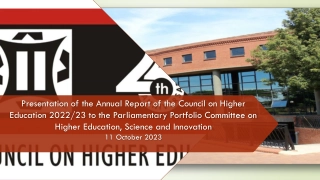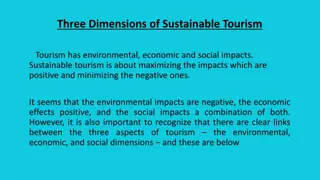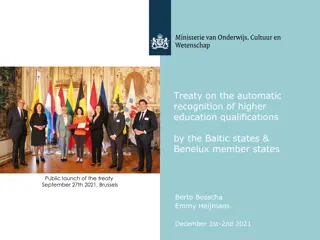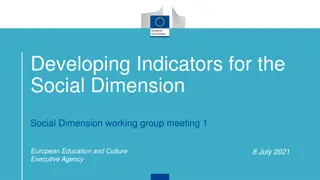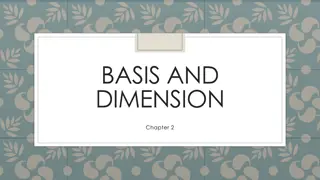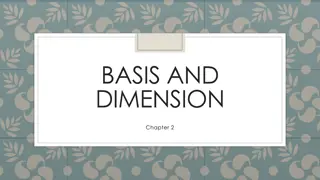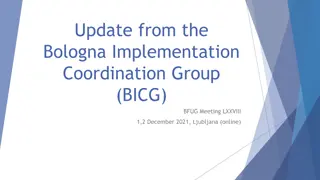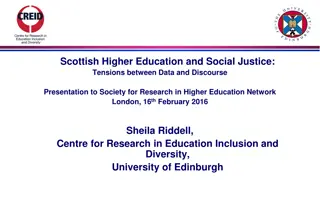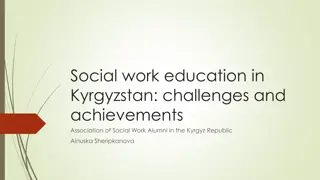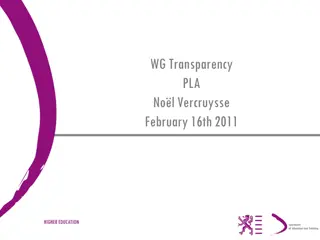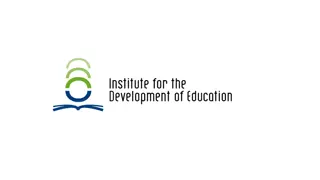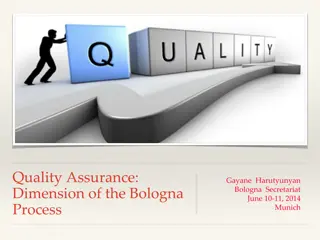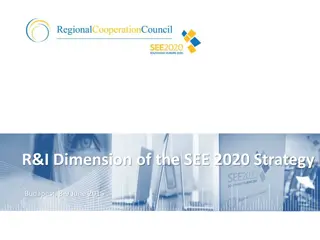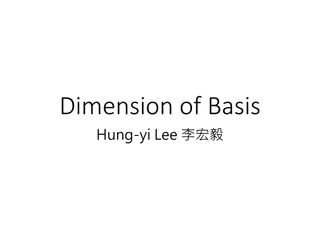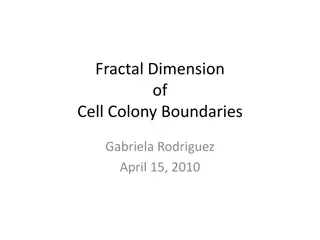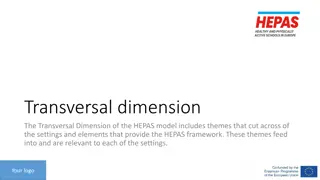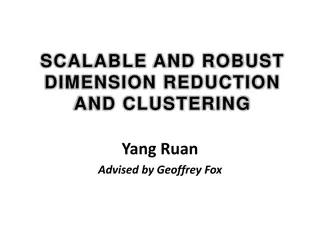Achievements in Social Dimension of Higher Education in EHEA 2018-2020
Focus on historical background, future principles, impact of COVID-19, policy developments, and building a European movement for the social dimension of higher education in the European Higher Education Area (EHEA) from 2018-2020. Explore initiatives to address underrepresentation, widening access, and equitable participation.
Download Presentation

Please find below an Image/Link to download the presentation.
The content on the website is provided AS IS for your information and personal use only. It may not be sold, licensed, or shared on other websites without obtaining consent from the author.If you encounter any issues during the download, it is possible that the publisher has removed the file from their server.
You are allowed to download the files provided on this website for personal or commercial use, subject to the condition that they are used lawfully. All files are the property of their respective owners.
The content on the website is provided AS IS for your information and personal use only. It may not be sold, licensed, or shared on other websites without obtaining consent from the author.
E N D
Presentation Transcript
Achievements related to the social dimension of higher education in the European Higher Education Area: focus on the period 2018-2020. Nino S. Schmidt Co-Chair (Croatia) of the BFUG Working Group on Social Dimension 2018-2020 and 2021- 2024 Institute for the Development of Education (IDE), Executive Director Zagreb, Croatia 2 BFUG Working Group on Social Dimension 2021-2024, 1st on-line meeting, 8.7.2021.
Achievements related to the social dimension in the EHEA in the period 2001-2020 CONTENT: 1. Historical background for social dimension 2. Future of Principles and Guidelines to Strengthen the Social Dimension of Higher Education in the EHEA 3. New needs: Impact of COVID-19 on the social dimension of higher education 4. New policy developments and opportunities for the social dimension in the EHEA 5. Building a European movement for the social dimension of higher education 3
Achievements related to the social dimension in the EHEA 2001-2020 1. Historical background for social dimension 4
Historical background Inclusion of underrepresented students Widening access Equitable access 2001 Prague Communiqu 2003 Berlin Communiqu 2005 Bergen Communiqu SOCIAL DIMENSION = composition of the student body entering, participating in and completing higher education at all levels should correspond to the heterogeneous social profile of society at large 1st 2007 London Communiqu definition 5
Historical background Strategy for social dimension 2015-2020 Link to lifelong learning 2012 Bucharest Communiqu Widening participation Flexibility of entry routes 2015 Yerevan Communiqu 2009 Leuven Communiqu Objectives to develop a common understanding of the concept of the social dimension in HE to develop principles and guidelines for social dimension Recognized the need to guide member states on how to define and implement policy 2018-2020 BFUG Advisory Group for Social Dimension Co-chairs: Croatia and ESU 2018 Paris Communiqu 6
Challenges 1. Recognized importance for the social dimension in HE in all key EHEA policy papers. In many EHEA countries, there are already measures in place to address the underrepresentation of particular societal groups in HE o But, these measures often create a set of isolated interventions and are not a part of a coherent national strategy for the social dimension enhancement. o Very few countries have developed national strategies or plans for fostering social dimension systematically. 2. The majority of countries have some targets related to widening access and participation in HE o However, most of these targets are about widening overall participation, without making reference to specific underrepresented groups. 7
Solution Key output of the BFUG Advisory Group for Social Dimension 2018-2020: a NEW forward-looking strategic document for the period 2020-2030 Principles and Guidelines to Strengthen the Social Dimension of Higher Education in the EHEA Objectives to develop a common understanding of the concept of the social dimension in HE to develop principles and guidelines for social dimension 2018-2020 BFUG Advisory Group for Social Dimension Co-chairs: Croatia and ESU 2018-2020 BFUG Advisory Group for Social Dimension Co-chairs: Croatia and ESU 2018-2020 BFUG Advisory Group for Social Dimension Co-chairs: Croatia and ESU 8
Achievements related to the social dimension in the EHEA 2018-2020 2. Future of Principles and Guidelines to Strengthen the Social Dimension of Higher Education in the EHEA 9
New definition: social dimension New: enlarged definition that goes beyond the London definition - by stressing that the social dimension encompasses the creation of an inclusive environment in higher education that fosters equity and diversity and is responsive to the needs of local communities. Definition: composition of the student body entering, participating in and completing higher education at all levels should correspond to the heterogeneous social profile of society at large Policy levers for identifying and improving the prospects of underrepresented, disadvantaged and vulnerable students Embraces a social justice agenda Starting point: definition in the 2007 London Communique New: fosters equity New: New: fosters diversity responsive to the needs of local communities New: Public authorities and higher education institutions need to integrate the principles into the core higher education mission: learning and teaching, research, innovation, knowledge exchange and outreach, institutional governance and management, policies for empowering students and staff. New: moving beyond widening accessability clauses and focusing on public good agenda by integrating principles in core HE mission and governance 10
Principles and Guidelines 10 principles for the social dimension for the upcoming decade: Principles = should be understood as high-level statements that serve as a basis for the conceptualization of different policies for social dimension enhancement. Guidelines = recommendations intended to advise policy makers on how the principles should be implemented in practice. Glossary of Terms and Definitions: o Underrepresented students o Disadvantaged students o Vulnerable students 11
Learning & teaching: reflect diversity of students needs Strategic approach Policy dialogue between public authorities and HEIs Supportive legal framework: Flexible and adaptable L&T, RPL Community engagement in HE promotes social dimension Principles & Guidelines for social dimension Inclusiveness of the entire education system: From early childhood edu to lifelong learning Inclusive and equitable international mobility programs Reliable data: for evidence-based improvements Strengthening HEIs capacity for diversity Effective counselling and guidance for students Sufficient and sustainable funding 12
Principles and Guidelines Highlights: Legal regulations and administrative rules should allow sufficient flexibility in the design, organization and delivery of study programs to reflect the diversity of students needs. o Higher education institutions should be enabled to organize full-time and part-time studies, flexible study modes, blended and distance learning as well as to recognize prior learning (RPL). It is important to ensure a holistic approach to the social dimension aiming to create coherent policies from early childhood education, through schooling to higher education and throughout lifelong learning. o This requires more connectivity between the work of those responsible for higher education and other ministries and sectors, which can bring about change only in a joint effort. 13
Learning & teaching: reflect diversity of students needs Strategic approach Policy dialogue between public authorities and HEIs Supportive legal framework: Flexible and adaptable L&T, RPL Community engagement in HE promotes social dimension Principles & Guidelines for social dimension Inclusiveness of the entire education system: From early childhood edu to lifelong learning Inclusive and equitable international mobility programs Reliable data: for evidence-based improvements Strengthening HEIs capacity for diversity Effective counselling and guidance for students Sufficient and sustainable funding 14
Principles and Guidelines Highlights: Higher education institutions should ensure that community engagement in higher education promotes diversity, equity and inclusion. o Such engagement provides a holistic basis on which universities can address a broad range of societal needs, including those of vulnerable, disadvantaged and underrepresented groups, while enriching their teaching, research and other core functions. 15
Learning & teaching: reflect diversity of students needs Strategic approach Policy dialogue between public authorities and HEIs Supportive legal framework: Flexible and adaptable L&T, RPL Community engagement in HE promotes social dimension Principles & Guidelines for social dimension Inclusiveness of the entire education system: From early childhood edu to lifelong learning Inclusive and equitable international mobility programs Reliable data: for evidence-based improvements Strengthening HEIs capacity for diversity Effective counselling and guidance for students Sufficient and sustainable funding 16
Principles and Guidelines Conclusion: Principles and Guidelines are not to be seen as a checklist, but as an instrument for developing fit-for purpose national and institutional strategies and policies for social dimension enhancement o Enabling concrete and tangible progress over the next decade Favourable moment: Principles and Guidelines adopted by the 48 EHEA ministers at the EHEA Rome Ministerial Conference on 19 November 2020 Principles and Guidelines are an integral part of the 2020 Rome Ministerial Communique - ministers have politically committed to its implementation. 17
Principles and Guidelines: next steps Next steps: Public authorities should engage in a policy dialogue with HEIs and other stakeholders to develop fit-for purpose policy measures > will enable progress towards diversity, equity, inclusion in higher education Important role for our BFUG WG on SD: definining indicators and benchmarks for the Principles! Public authorities should support the implementation of the Principles and Guidelines by offering a legal, financial, administrative and informative framework that can initiate process of implementation at the national level Important role for our BFUG WG on SD: developing a system of monitoring the implementation of the Principles! 18
Achievements related to the social dimension in the EHEA 3. New needs: Impact of COVID-19 on the social dimension of higher education 19
Impact of COVID-19 on the social dimension At-risk students will be disproportionally affected. COVID-19 crisis is exacerbating pre-existing education disparities, rather than causing those disparities. o Now at-risk students face a range of additional challenges in accessing higher education, participating fully in their study programs and successfully completing their studies. (NESET Analytical Report, Farnell et al., 2021) 20
Immediate impact of COVID-19 on the social dimension WHAT: overview of challenges faced by the EHEA students during COVID-19 pandemic Learning and teaching challenges: almost 60 % reported they do not always have a reliable internet connection almost 70 % reported they do not always have access to course study materials almost 35 % of students did not often have a quiet place to study (ESU Survey, Doolan et al., 2021) 21
Immediate impact of COVID-19 on the social dimension WHAT: overview of challenges faced by the EHEA students during COVID-19 pandemic Funding challenges: almost 40 % of students who worked during their studies lost their jobs almost 15 % of students had significant financial concerns about their study costs (ESU Survey, Doolan et al., 2021) 22
Immediate impact of COVID-19 on the social dimension WHAT: overview of challenges faced by the EHEA students during COVID-19 pandemic Students well-being challenges: Students have frequently felt frustrated and anxious in their academic activities since on-site classes had been cancelled. Lower levels of general well-being were reported by students who do not have a supportive social network: almost 10 % of students indicated that they do not have several people they can trust to help solve their problems. (ESU Survey, Doolan et al., 2021) 23
Immediate impact of COVID-19 on the social dimension WHO: identifying students more likely to face difficulties in adjusting to studying during the COVID-19 pandemic lockdown: Students at lower levels of study Students lacking a supportive social network Students who reported having mental health problems Students with lower levels of digital skills Students who do not have a quiet place to study, a good internet connection and material for studying at their disposal (ESU Survey, Doolan et al., 2021) 24
Conclusion: Impact of COVID-19 on the social dimension short term (next year) and medium term (up to 2025) Pandemic will have negative impact on equity and social inclusion in pre-tertiary education >>> creating a knock-on effect of: a) reducing equal access to higher education b) lowering the level of participation of at-risk students in higher education in the upcoming years. o Long-term scarring effects for young people under the age of 25 the COVID generation resulting in an unprecedented decline in social mobility due to rising economic and educational inequalities. 25 (NESET Analytical Report, Farnell et al., 2021)
Achievements related to the social dimension in the EHEA 4. New policy developments and opportunities for the social dimension in the EHEA 26
New policy developments and opportunities for the social dimension Important to consider > what opportunities that the COVID-19 crisis provides for addressing challenges faced by higher education systems and universities. Provides an opportunity to place the inclusion of underrepresented, vulnerable and disadvantage groups as a top priority in the efforts to address the disruption caused by COVID-19 2020 Rome Ministerial Communiqu > 49 ministers of higher education committed to build an inclusive, innovative and interconnected European Higher Education Area (EHEA) by 2030. 27
New policy developments and opportunities for the social dimension: EHEA 2020 Rome Ministerial Communiqu - an inclusive EHEA: Adopted a new strategic document Principles and Guidelines to Strengthen the Social Dimension of Higher Education in the EHEA Novelty (for the 1st time): guidelines intended to advise policy makers on how the principles should be implemented in practice integral part of the 2020 Rome Ministerial Communique - ministers have politically committed to its implementation 28
New policy developments and opportunities for the social dimension: EHEA European University Association (2021): Universities without walls: a vision for 2030 Priorities for action: one of the three key areas in which European universities see major potential for moving forward in increasing societal engagement and contributing to sustainable development is strengthening of their civic engagement Diversity and social cohesion are important components of sustainable development Universities and their missions will widely benefit from equity and inclusion, and it is therefore in their core interest to promote these values in society 29
New policy developments and opportunities for the social dimension: EU Achieving the European Education Area by 2025 (European Commission, 2020): One of the six dimensions necessary to further develop the EEA refers to inclusion and gender equality. Educational attainment and achievement should be decoupled from social, economic and cultural status, to ensure that education and training systems boost the abilities of every individual and enable upward social mobility 30
New policy developments and opportunities for the social dimension: EU European Universities initiative (European Commission 2019-2020): 2021-2027: the Commission will further optimize the vision of the European Universities to address big societal challenges, become true engines of development for cities and regions and promote civic engagement fostered by the European Universities alliances whose mission is dedicated to fostering inclusive higher education - as the alliance Young Universities for the Future of Europe (YUFE) already demonstrates 31
Achievements related to the social dimension in the EHEA 5. Building a European movement for the social dimension of higher education: 2020-2030: The decade of the social dimension in the EHEA? 32
Building a European movement: recommended policy approaches TOP-DOWN approach: Focus on building capacities of public authorities and universities for the social dimension and on facilitating a learning journey, rather than on compliance o Explore transnational learning and capacity tools o Scale up through incentives BFUG Working Group for Social Dimension 2021-2024 (www.ehea.info): o Developing tools for the implementation of Principles for the social dimension o Developing a system of monitoring the implementation of the Principles and Guidelines o Organizing peer support activities for social dimension to support the implementation of the Principles and Guidelines among the EHEA members 33
Building a European movement: recommended policy approaches BOTTOM-UP approach: Identify public authorities and universities committed to the social dimension Build a network of institutions committed to the social dimension and organize capacity building events with them Build other alliances and scale up: connect the social dimension agenda to the European Universities initiative and similar global networks, etc. (NESET Analytical Report, Farnell et al., 2021) TOP-DOWN approach + BOTTOM-UP approach = building a European movement for the social dimension 2020-2030: The decade of the social dimension in the EHEA? 34
Thank you for your attention! Ninoslav ukanec Schmidt Co-Chair (Croatia) of the BFUG Working Group on Social Dimension 2018-2020 and 2021-2024 Institute for the Development of Education (IDE) Zagreb, Croatia nscukanec@iro.hr www.iro.hr BFUG Working Group for Social Dimension: https://ehea.info/ 35


